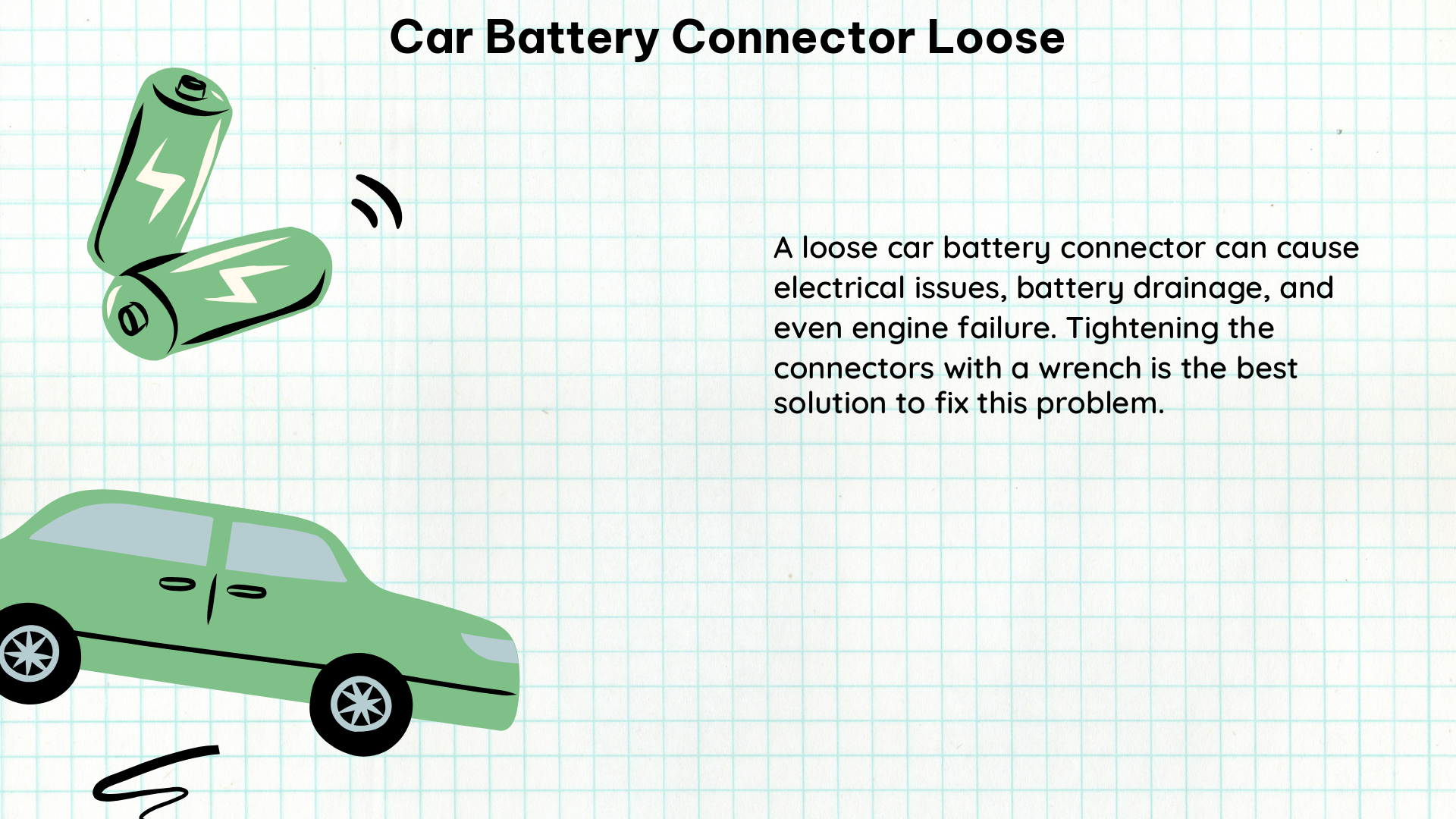A loose car battery connector can lead to various issues, including difficulty starting the vehicle, intermittent power supply interruptions, and even steering wheel lock-up. This comprehensive guide will provide you with a step-by-step approach to diagnose and address this common problem, ensuring your car’s electrical system functions smoothly.
Identifying the Problem: Symptoms of a Loose Car Battery Connector
When the car battery connector is loose, you may experience the following symptoms:
- Difficulty Starting the Vehicle: A loose connection can prevent the starter from receiving the necessary power to crank the engine, making it challenging to start the car.
- Intermittent Power Interruptions: The loose connection can cause the power supply to the various electrical components in the car to be interrupted, leading to issues such as flickering lights, sudden loss of power, or even the steering wheel locking up.
- Battery Drain: A loose connection can cause the battery to discharge more quickly, as the electrical system is not receiving a consistent power supply.
- Electrical System Malfunctions: The loose connection can lead to various electrical system issues, such as the radio cutting out, the dashboard lights flickering, or the engine management system experiencing errors.
Diagnosing the Issue: Quantifiable Data to Consider

When addressing a loose car battery connector, it is crucial to gather and analyze the following quantifiable data to ensure a thorough diagnosis and effective solution:
- Tightness of the Bolts: Use a torque wrench to measure the tightness of the bolts securing the battery terminals. The manufacturer’s recommended torque specifications should be followed to ensure a secure connection.
- Distance of Cable Movement: Measure the distance the cable can move when the connection is loose. Compare this measurement to the manufacturer’s specifications to determine if the connection is within acceptable limits.
- Corrosion Levels: Inspect the battery terminals and connectors for signs of corrosion. Use a corrosion meter or a visual inspection to quantify the level of corrosion present.
- Alternator Output: Measure the alternator’s output voltage and current to ensure it is within the manufacturer’s specifications. A failing alternator can contribute to a loose battery connection.
Addressing the Issue: Solutions for a Loose Car Battery Connector
Once you have gathered the necessary data, you can consider the following solutions to address the loose car battery connector:
-
Tightening the Bolts: Ensure that the bolts securing the battery terminals are tightened to the manufacturer’s recommended torque specifications. Use a torque wrench to achieve the correct tightness.
-
Using Aluminum Foil: As a temporary solution, you can wrap a small piece of aluminum foil around the battery terminal to create a tighter connection. However, this is not a long-term fix and should be replaced with a more permanent solution.
-
Cotter Pin Fix: A simple and cost-effective solution is to use a cotter pin to secure the battery terminal to the post. This method can help prevent the terminal from moving and provide a more secure connection.
-
Removing Plastic Spacers: If there are plastic spacers under the battery terminal clamp, removing them can help create a tighter connection by reducing the distance between the terminal and the post.
-
Using Battery Terminal Sleeves: These sleeves fit over the battery post and allow you to tighten the clamp, providing a more secure connection.
-
Cleaning the Terminals: Corrosion on the battery terminals can contribute to a loose connection. Clean the terminals using a baking soda and water solution, and an old toothbrush to remove any buildup.
-
Checking the Alternator: If the car cannot run without the battery, it may indicate a failing alternator. Measure the alternator’s output to ensure it is within the manufacturer’s specifications and replace it if necessary.
Preventive Measures: Maintaining a Secure Car Battery Connector
To prevent future issues with a loose car battery connector, consider the following preventive measures:
- Regular Inspection: Periodically inspect the battery terminals and connectors for signs of corrosion or looseness. Tighten the bolts as needed and clean the terminals to maintain a secure connection.
- Use of Battery Terminal Protectors: Applying a battery terminal protector, such as a dielectric grease or a corrosion-inhibiting spray, can help prevent the formation of corrosion and maintain a secure connection.
- Proper Battery Replacement: When replacing the car battery, ensure that the new battery is compatible with the vehicle and that the terminals are properly secured.
- Monitoring Electrical System Performance: Keep an eye on the overall performance of the car’s electrical system, such as the battery charge level, alternator output, and any warning lights or error codes. Addressing any issues promptly can help prevent a loose battery connector.
By following the steps outlined in this comprehensive guide, you can effectively diagnose and address a loose car battery connector, ensuring your vehicle’s electrical system functions reliably and preventing potential issues down the road.
References:
- Loose Starter Cables: One Click Then Nothing
- Loose Positive Battery Terminal Cable
- How to Fix a Loose Battery Terminal
- The Positive Always Gets Loose No Matter How Much I Tighten It
- Loose Battery Cable Clamp Connection

The lambdageeks.com Core SME Team is a group of experienced subject matter experts from diverse scientific and technical fields including Physics, Chemistry, Technology,Electronics & Electrical Engineering, Automotive, Mechanical Engineering. Our team collaborates to create high-quality, well-researched articles on a wide range of science and technology topics for the lambdageeks.com website.
All Our Senior SME are having more than 7 Years of experience in the respective fields . They are either Working Industry Professionals or assocaited With different Universities. Refer Our Authors Page to get to know About our Core SMEs.